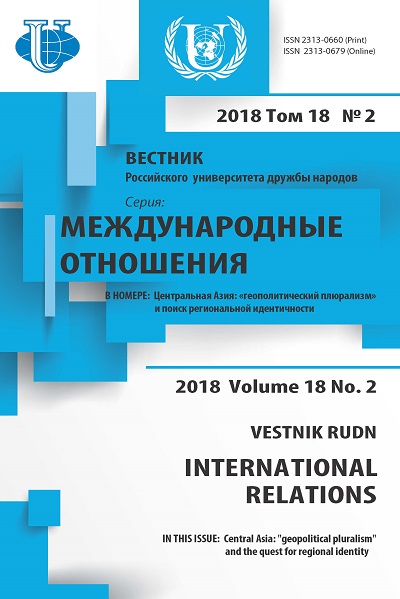POST-SOVIET STATES: CHALLENGES OF DEVELOPMENT
- 作者: Krylov A.B.1
-
隶属关系:
- The Primakov Institute of World Economy and International Relations
- 期: 卷 18, 编号 2 (2018): Central Asia: “geopolitical pluralism” and the quest for regional identity
- 页面: 247-258
- 栏目: THEMATIC DOSSIER
- URL: https://journals.rudn.ru/international-relations/article/view/18877
- DOI: https://doi.org/10.22363/2313-0660-2018-18-2-247-258
如何引用文章
全文:
详细
The purpose of this article is to analyze the most significant processes and trends within the former USSR area associated, primarily, with domestic economic and political problems, the results of 25 years of independent development of former Soviet republics, specifics of their political and social and economic transformation. These and other topics are considered in the context of Russia’s interests and the role of Russia on the post-Soviet territory.The author’s opinion is that a typical feature of oligarchic regimes in the post-Soviet states has become a refusal to have an independent policy and a course aimed at the introduction of an external control. In this case, the sovereignty and national interests of a country are sacrificed for the interests of the transnational oligarchy. Local politicians and oligarchs act as its agents. Naturally the externally controlled countries (Georgia, Moldova and Ukraine) have found themselves far behind the other post-Soviet states.According to the author, the most successful of the post-Soviet states have become the states with a well-developed and rigid administrative and bureaucratic vertical of authority, which was able to limit the role of the oligarchy and local criminal structures in politics. Acting in this way, the nation-oriented part of the government and business have managed to prevent the dictatorship of the transnational oligarchy, overcome the negative implications of transformational crisis and ensure internal political, social and economic strength within new state boundaries. This creates opportunities for accelerated modernization and construction of a more democratic state system.
作者简介
Alexander Krylov
The Primakov Institute of World Economy and International Relations
编辑信件的主要联系方式.
Email: abkrylov@mail.ru
Doctor of History, Head of Center for post-Soviet studies of the Primakov Institute of World Economy and International Relations, President of the Scholarly Society of Caucasus Studies
参考
- Aslund, A. (2007). How Capitalism Was Built: The Transformation of Central and Eastern Europe, Russia, and Central Asia. Cambridge University Press. DOI: https://doi.org/10.1017/ CBO9780511790416
- Beck, U. (2001). What is globalization? The errors of globalism - Answers to globalizations. Translation from German. Moscow: Progress-Traditsiya. (In Russ.)
- Collins, K. (2006). Clan Politics and Regime Transition in Central Asia. Cambridge University Press. doi: 10.1017/CBO9780511510014
- Dillinger, W. (2007). Poverty and Regional Development in Eastern Europe and Central Asia. World Bank Working Paper No. 118. Washington, DC: World Bank
- Everett-Heath, T. (2003). Central Asia: Aspects of Transition. London and New York: Routledge Curzon.
- Barrows, М. & Dynkin, A. (Eds.) (2016). Global System on the Brink: Pathways toward a New Normal. IMEMO RAS and The Atlantic Council (USA). Мoscow: Magistr.
- Iskandaryan, A. (2011). Armenia between autocracy and polyarchy. Pro et Contra, May-August, 19-28. (In Russ.).
- Jones Luong, P. (2002). Institutional Change and Political Continuity in Post-Soviet Central Asia: Power, Perceptions, and Pacts. New York: Cambridge University Press.
- Jonson, L. (2006). Tajikistan in the New Central Asia: Geopolitics, Great Power Rivalry and Radical Islam (International Library of Central Asia Studies). New York: I.B. Tauris.
- Krylov, A.B., Areshev, A.G. (2014). Eurasian Integration: Problems and Potential for Development. Russia and the New States of Eurasia, 4 (25), 23-33. (In Russ.).
- Malysheva, D.B. (2018). Conflict Resolution on the post-Soviet territories and beyond. World Economy and International Relations, 2 (62), 111-114. (In Russ.)
- Malysheva, D.B. (2004). Democratization of the post-Soviet East: Models and Realities. World Economy and International Relations, 6, 85-95. (In Russ.)
- Nisnevich, Yu.A. & Ryabov, A.V. (2016). Modern authoritarianism and political ideology. Polis. Political Research, 4, 162-181. doi: 10.17976/jpps/2016.04.13. (In Russ.)
- Sakwa, R. (2016). The global crisis: Russia looking for a way out from the dead end. Polis. Political Research, 6, 52-68. doi: 10.17976/jpps/2016.06.05. (In Russ.).
- Shurubovich, A. (2013). The Ukranian economy going through modernization. Russia and new countries in Eurasia, 3, 24-37. (In Russ.).
- Spechler, M.C. (2008). The Political Economy of Reform in Central Asia: Uzbekistan under Authoritarianism. New York: Routledge.
- Syroezhkin, K.L. (2013). The specific features of the state formation in Central Asia (based on Kazakhstan and Kyrgyzstan). Transformation and conflicts in Central Asia and the Caucasus, 140-167. (In Russ.).
- Syzdykova, Zh.S. (2013). Russia’s Geopolitical Interests in Central Asia. Theory and Practice of Social Development, 8, 263-265. (In Russ.).
- Wooden, A.E., Stefes, C.H. (2009). The Politics of Transition in Central Asia and the Caucasus: Enduring Legacies and Emerging Challenges (Central Asian Studies). Routledge.
- Years that have changed the Central Asia. (2009). Мoscow: Centre of Strategic and Political Research, The Institute of Oriental Studies of the Russian Academy of Sciences. (In Russ.).








